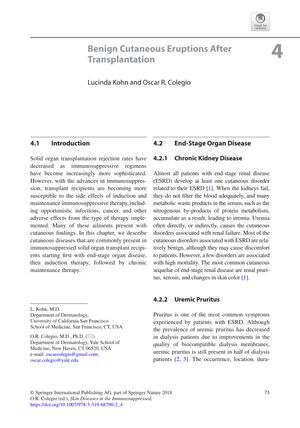Benign Cutaneous Eruptions After Transplantation
December 2017
in “
Springer eBooks
”

TLDR Transplant patients often get skin problems, with treatments varying by condition.
The document from 2017 details a range of benign skin conditions that commonly affect immunosuppressed solid organ transplant recipients, particularly those with end-stage renal disease (ESRD) and liver failure. It notes that nearly all ESRD patients develop at least one skin disorder, with renal pruritus, xerosis, and skin color changes being the most common. Specific conditions like calciphylaxis, which is often fatal, and halogenodermas are also discussed. For liver failure patients, jaundice and estrogen-related dermatoses are typical. The document further explains that immunosuppressive therapy post-transplantation can lead to various side effects, including serum sickness, nephrotoxicity, neurotoxicity, non-scarring alopecia, and increased infection risk. It also mentions that 10%-20% of patients on tacrolimus may experience non-scarring alopecia, and up to 92% of transplant recipients develop verrucae within 5 years. Management strategies vary, with some conditions improving after organ transplantation or cessation of the causative agent, while others may require specific treatments like UVB phototherapy, activated charcoal, antiviral agents, or dose adjustments of immunosuppressive medications.






